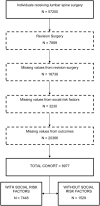Quantifying the collective influence of social determinants of health using conditional and cluster modeling
- PMID: 33152044
- PMCID: PMC7644039
- DOI: 10.1371/journal.pone.0241868
Quantifying the collective influence of social determinants of health using conditional and cluster modeling
Abstract
Objectives: Our objective was to analyze the collective effect of social determinants of health (SDoH) on lumbar spine surgery outcomes utilizing two different statistical methods of combining variables.
Methods: This observational study analyzed data from the Quality Outcomes Database, a nationwide United States spine registry. Race/ethnicity, educational attainment, employment status, insurance payer, and gender were predictors of interest. We built two models to assess the collective influence of SDoH on outcomes following lumbar spine surgery-a stepwise model using each number of SDoH conditions present (0 of 5, 1 of 5, 2 of 5, etc) and a clustered subgroup model. Logistic regression analyses adjusted for age, multimorbidity, surgical indication, type of lumbar spine surgery, and surgical approach were performed to identify the odds of failing to demonstrate clinically meaningful improvements in disability, back pain, leg pain, quality of life, and patient satisfaction at 3- and 12-months following lumbar spine surgery.
Results: Stepwise modeling outperformed individual SDoH when 4 of 5 SDoH were present. Cluster modeling revealed 4 distinct subgroups. Disparities between the younger, minority, lower socioeconomic status and the younger, white, higher socioeconomic status subgroups were substantially wider compared to individual SDoH.
Discussion: Collective and cluster modeling of SDoH better predicted failure to demonstrate clinically meaningful improvements than individual SDoH in this cohort. Viewing social factors in aggregate rather than individually may offer more precise estimates of the impact of SDoH on outcomes.
Conflict of interest statement
I have read the journal’s policy and the authors of this manuscript have the following competing interests: ONG reports personal fees from RTI pioneer and Medtronic, outside the submitted work. ZDR, ANG, and CEC certify that they have no affiliations with or financial involvement in any organization or entity with a direct financial interest in the subject matter or materials discussed in the article. This does not alter our adherence to PLOS ONE policies on sharing data and materials.
Figures




Similar articles
-
The Collective Influence of Social Determinants of Health on Individuals Who Underwent Lumbar Spine Revision Surgeries: A Retrospective Cohort Study.World Neurosurg. 2022 Sep;165:e619-e627. doi: 10.1016/j.wneu.2022.06.107. Epub 2022 Jun 27. World Neurosurg. 2022. PMID: 35772707
-
An analysis from the Quality Outcomes Database, Part 1. Disability, quality of life, and pain outcomes following lumbar spine surgery: predicting likely individual patient outcomes for shared decision-making.J Neurosurg Spine. 2017 Oct;27(4):357-369. doi: 10.3171/2016.11.SPINE16526. Epub 2017 May 12. J Neurosurg Spine. 2017. PMID: 28498074
-
Quantification of Neighborhood-Level Social Determinants of Health in the Continental United States.JAMA Netw Open. 2020 Jan 3;3(1):e1919928. doi: 10.1001/jamanetworkopen.2019.19928. JAMA Netw Open. 2020. PMID: 31995211 Free PMC article.
-
Social determinants of health in prognostic machine learning models for orthopaedic outcomes: A systematic review.J Eval Clin Pract. 2023 Mar;29(2):292-299. doi: 10.1111/jep.13765. Epub 2022 Sep 13. J Eval Clin Pract. 2023. PMID: 36099267
-
The impact of social determinants of health on utilization of pediatric epilepsy surgery: a systematic review.J Neurosurg Pediatr. 2024 Apr 5;34(1):30-39. doi: 10.3171/2024.1.PEDS23128. Print 2024 Jul 1. J Neurosurg Pediatr. 2024. PMID: 38579357
Cited by
-
The impact of social determinants of health on early outcomes after adult Chiari surgery.Geroscience. 2024 Apr;46(2):1451-1459. doi: 10.1007/s11357-023-01021-y. Epub 2023 Nov 24. Geroscience. 2024. PMID: 37996723 Free PMC article.
-
Association of Burden and Prevalence of Arthritis With Disparities in Social Risk Factors, Findings From 17 US States.Prev Chronic Dis. 2022 Feb 17;19:E08. doi: 10.5888/pcd19.210277. Prev Chronic Dis. 2022. PMID: 35175917 Free PMC article.
-
Engagement and Utilization of a Complete Remote Digital Care Program for Musculoskeletal Pain Management in Urban and Rural Areas Across the United States: Longitudinal Cohort Study.JMIR Mhealth Uhealth. 2023 Mar 16;11:e44316. doi: 10.2196/44316. JMIR Mhealth Uhealth. 2023. PMID: 36735933 Free PMC article.
-
The association between total social exposure and incident multimorbidity: A population-based cohort study.SSM Popul Health. 2024 Dec 28;29:101743. doi: 10.1016/j.ssmph.2024.101743. eCollection 2025 Mar. SSM Popul Health. 2024. PMID: 39850956 Free PMC article.
-
Analyzing Multiple Social Determinants of Health Using Different Clustering Methods.Int J Environ Res Public Health. 2024 Jan 28;21(2):145. doi: 10.3390/ijerph21020145. Int J Environ Res Public Health. 2024. PMID: 38397636 Free PMC article.
References
-
- Lee JY, Whang PG, Lee JY, Phillips FM, Patel AA. Lumbar spinal stenosis. Instr Course Lect. 2013;62:383–96. Epub 2013/02/12. . - PubMed
Publication types
MeSH terms
LinkOut - more resources
Full Text Sources

